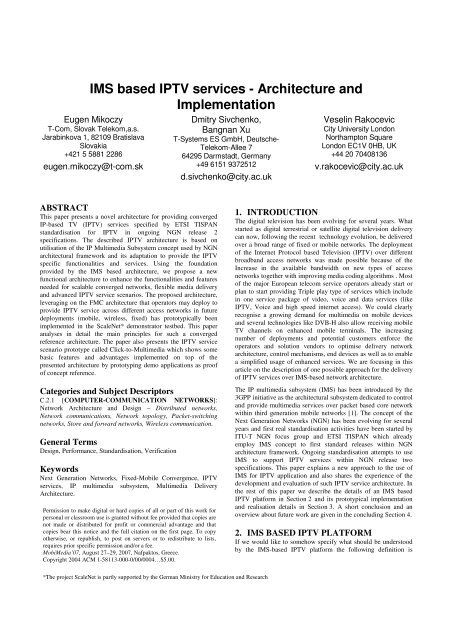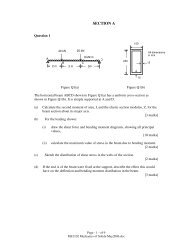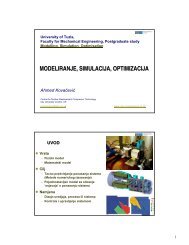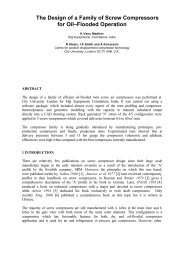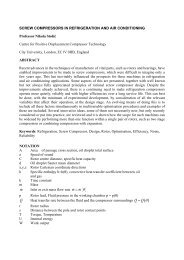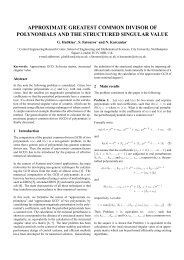IMS based IPTV services - Architecture and Implementation
IMS based IPTV services - Architecture and Implementation
IMS based IPTV services - Architecture and Implementation
You also want an ePaper? Increase the reach of your titles
YUMPU automatically turns print PDFs into web optimized ePapers that Google loves.
<strong>IMS</strong> <strong>based</strong> <strong>IPTV</strong> <strong>services</strong> - <strong>Architecture</strong> <strong>and</strong><br />
<strong>Implementation</strong><br />
Eugen Mikoczy<br />
T-Com, Slovak Telekom,a.s.<br />
Jarabinkova 1, 82109 Bratislava<br />
Slovakia<br />
+421 5 5881 2286<br />
eugen.mikoczy@t-com.sk<br />
Dmitry Sivchenko,<br />
Bangnan Xu<br />
T-Systems ES GmbH, Deutsche-<br />
Telekom-Allee 7<br />
64295 Darmstadt, Germany<br />
+49 6151 9372512<br />
d.sivchenko@city.ac.uk<br />
Veselin Rakocevic<br />
City University London<br />
Northampton Square<br />
London EC1V 0HB, UK<br />
+44 20 70408136<br />
v.rakocevic@city.ac.uk<br />
ABSTRACT<br />
This paper presents a novel architecture for providing converged<br />
IP-<strong>based</strong> TV (<strong>IPTV</strong>) <strong>services</strong> specified by ETSI TISPAN<br />
st<strong>and</strong>ardisation for <strong>IPTV</strong> in ongoing NGN release 2<br />
specifications. The described <strong>IPTV</strong> architecture is <strong>based</strong> on<br />
utilisation of the IP Multimedia Subsystem concept used by NGN<br />
architectural framework <strong>and</strong> its adaptation to provide the <strong>IPTV</strong><br />
specific functionalities <strong>and</strong> <strong>services</strong>. Using the foundation<br />
provided by the <strong>IMS</strong> <strong>based</strong> architecture, we propose a new<br />
functional architecture to enhance the functionalities <strong>and</strong> features<br />
needed for scalable converged networks, flexible media delivery<br />
<strong>and</strong> advanced <strong>IPTV</strong> service scenarios. The proposed architecture,<br />
leveraging on the FMC architecture that operators may deploy to<br />
provide <strong>IPTV</strong> service across different access networks in future<br />
deployments (mobile, wireless, fixed) has prototypically been<br />
implemented in the ScaleNet* demonstrator testbed. This paper<br />
analyses in detail the main principles for such a converged<br />
reference architecture. The paper also presents the <strong>IPTV</strong> service<br />
scenario prototype called Click-to-Multimedia which shows some<br />
basic features <strong>and</strong> advantages implemented on top of the<br />
presented architecture by prototyping demo applications as proof<br />
of concept reference.<br />
Categories <strong>and</strong> Subject Descriptors<br />
C.2.1 [COMPUTER-COMMUNICATION NETWORKS]:<br />
Network <strong>Architecture</strong> <strong>and</strong> Design – Distributed networks,<br />
Network communications, Network topology, Packet-switching<br />
networks, Store <strong>and</strong> forward networks, Wireless communication.<br />
General Terms<br />
Design, Performance, St<strong>and</strong>ardisation, Verification<br />
Keywords<br />
Next Generation Networks, Fixed-Mobile Convergence, <strong>IPTV</strong><br />
<strong>services</strong>, IP multimedia subsystem, Multimedia Delivery<br />
<strong>Architecture</strong>.<br />
Permission to make digital or hard copies of all or part of this work for<br />
personal or classroom use is granted without fee provided that copies are<br />
not made or distributed for profit or commercial advantage <strong>and</strong> that<br />
copies bear this notice <strong>and</strong> the full citation on the first page. To copy<br />
otherwise, or republish, to post on servers or to redistribute to lists,<br />
requires prior specific permission <strong>and</strong>/or a fee.<br />
MobiMedia’07, August 27–29, 2007, Nafpaktos, Greece.<br />
Copyright 2004 ACM 1-58113-000-0/00/0004…$5.00.<br />
1. INTRODUCTION<br />
The digital television has been evolving for several years. What<br />
started as digital terrestrial or satellite digital television delivery<br />
can now, following the recent technology evolution, be delivered<br />
over a broad range of fixed or mobile networks. The deployment<br />
of the Internet Protocol <strong>based</strong> Television (<strong>IPTV</strong>) over different<br />
broadb<strong>and</strong> access networks was made possible because of the<br />
Increase in the available b<strong>and</strong>width on new types of access<br />
networks together with improving media coding algorithms . Most<br />
of the major European telecom service operators already start or<br />
plan to start providing Triple play type of <strong>services</strong> which include<br />
in one service package of video, voice <strong>and</strong> data <strong>services</strong> (like<br />
<strong>IPTV</strong>, Voice <strong>and</strong> high speed internet access). We could clearly<br />
recognise a growing dem<strong>and</strong> for multimedia on mobile devices<br />
<strong>and</strong> several technologies like DVB-H also allow receiving mobile<br />
TV channels on enhanced mobile terminals. The increasing<br />
number of deployments <strong>and</strong> potential customers enforce the<br />
operators <strong>and</strong> solution vendors to optimise delivery network<br />
architecture, control mechanisms, end devices as well as to enable<br />
a simplified usage of enhanced <strong>services</strong>. We are focusing in this<br />
article on the description of one possible approach for the delivery<br />
of <strong>IPTV</strong> <strong>services</strong> over <strong>IMS</strong>-<strong>based</strong> network architecture.<br />
The IP multimedia subsystem (<strong>IMS</strong>) has been introduced by the<br />
3GPP initiative as the architectural subsystem dedicated to control<br />
<strong>and</strong> provide multimedia <strong>services</strong> over packet <strong>based</strong> core network<br />
within third generation mobile networks [1]. The concept of the<br />
Next Generation Networks (NGN) has been evolving for several<br />
years <strong>and</strong> first real st<strong>and</strong>ardisation activities have been started by<br />
ITU-T NGN focus group <strong>and</strong> ETSI TISPAN which already<br />
employ <strong>IMS</strong> concept to first st<strong>and</strong>ard releases within NGN<br />
architecture framework. Ongoing st<strong>and</strong>ardisation attempts to use<br />
<strong>IMS</strong> to support <strong>IPTV</strong> <strong>services</strong> within NGN release two<br />
specifications. This paper explains a new approach to the use of<br />
<strong>IMS</strong> for <strong>IPTV</strong> application <strong>and</strong> also shares the experience of the<br />
development <strong>and</strong> evaluation of such <strong>IPTV</strong> service architecture. In<br />
the rest of this paper we describe the details of an <strong>IMS</strong> <strong>based</strong><br />
<strong>IPTV</strong> platform in Section 2 <strong>and</strong> its prototypical implementation<br />
<strong>and</strong> realisation details in Section 3. A short conclusion <strong>and</strong> an<br />
overview about future work are given in the concluding Section 4.<br />
2. <strong>IMS</strong> BASED <strong>IPTV</strong> PLATFORM<br />
If we would like to somehow specify what should be understood<br />
by the <strong>IMS</strong>-<strong>based</strong> <strong>IPTV</strong> platform the following definition is<br />
*The project ScaleNet is partly supported by the German Ministry for Education <strong>and</strong> Research
possible: <strong>IMS</strong> <strong>based</strong> <strong>IPTV</strong> platform is service platform<br />
architecture which is able to provide <strong>IPTV</strong> <strong>services</strong> controlled <strong>and</strong><br />
h<strong>and</strong>led by <strong>IMS</strong> core subsystem <strong>and</strong> delivered independently from<br />
underlying IP transport networks. There exist at least three<br />
different stages of evolution for <strong>IPTV</strong> architecture:<br />
1. Non-NGN <strong>based</strong> <strong>IPTV</strong> solutions (almost all available solutions<br />
on market for now). It is possible to make some interworking<br />
with NGN but generally a separate service control <strong>and</strong><br />
application layer were developed specially for <strong>IPTV</strong> <strong>services</strong><br />
(<strong>IPTV</strong> middleware).<br />
2. NGN <strong>based</strong> <strong>IPTV</strong> architecture. It enables interaction <strong>and</strong><br />
interworking over specified reference point between <strong>IPTV</strong><br />
application <strong>and</strong> some existing common NGN components.<br />
These components include transport control elements for<br />
resource admission <strong>and</strong> control subsystem (RACS) or the<br />
TISPAN network attachment subsystem (NASS). This approach<br />
uses a dedicated <strong>IPTV</strong> subsystem within NGN to provide all<br />
necessary <strong>IPTV</strong> required functionalities.<br />
3. <strong>IMS</strong> <strong>based</strong> <strong>IPTV</strong> architecture. It specifies <strong>IPTV</strong> functions<br />
supported by the <strong>IMS</strong> subsystem <strong>and</strong> employs these functions to<br />
allow reused <strong>IMS</strong> functions <strong>and</strong> also make service initiation <strong>and</strong><br />
control <strong>based</strong> on SIP (Session Initiation Protocol). This paper<br />
presents one solution achieved with this concept.<br />
<strong>IPTV</strong> <strong>services</strong> can be divided in three main groups of <strong>services</strong><br />
(but not limited just for those in future):<br />
• Broadcast <strong>services</strong> (BC): live TV <strong>and</strong> radio channel feeds<br />
broadcasted or multicasted over network<br />
• Content on dem<strong>and</strong> (CoD): generally unicast <strong>services</strong> provided<br />
on subscriber dem<strong>and</strong> to deliver required content (e.g. movie,<br />
song, etc.)<br />
• Personal video recorder <strong>services</strong> (PVR) include <strong>services</strong> which<br />
allows recording, pause or time shift capabilities for live content<br />
(can be provided by network or by UE).<br />
2.1 The advantages of <strong>IMS</strong> <strong>based</strong> <strong>IPTV</strong><br />
concept<br />
Deploying <strong>IMS</strong> functionalities to support <strong>IPTV</strong> <strong>services</strong> enables<br />
more interesting <strong>IPTV</strong> features as follows:<br />
• Integrated user registration <strong>and</strong> authentication (single sign-on)<br />
• User subscription management<br />
• Session management, routing, service trigger, numbering<br />
• Interaction with existing NGN service enablers (presence,<br />
messaging, group management, etc.)<br />
• Roam <strong>and</strong> nomadic support<br />
• QoS <strong>and</strong> bearer control<br />
• Unified charging <strong>and</strong> billing<br />
The <strong>IMS</strong> <strong>based</strong> <strong>IPTV</strong> can also bring additional advantages such as<br />
support for mobility, enabling interaction with existing NGN<br />
service enablers, service personalisation <strong>and</strong> media adaptation as<br />
well as provide converged applications integrated voice, data,<br />
video <strong>and</strong> mobile <strong>services</strong> to flexible quadruple play service<br />
concept (in the future proof of concept called sometimes also<br />
multi-play <strong>services</strong>).<br />
2.2 <strong>IMS</strong> <strong>based</strong> functional architecture for<br />
<strong>IPTV</strong> <strong>services</strong><br />
The functional architecture of <strong>IMS</strong> <strong>based</strong> <strong>IPTV</strong> presented in this<br />
section contains main functions <strong>and</strong> reference points defined in<br />
TISPAN <strong>IMS</strong> <strong>IPTV</strong> concept. The following sections describe the<br />
main functions, including the service control function, the media<br />
control function <strong>and</strong> the media delivery function. We enhance the<br />
short description from original TISPAN drafts [2] (originally<br />
described in TISPAN Work item 2048) <strong>and</strong> include our<br />
extensions presented in TISPAN draft WG2TD11 [3] but more as<br />
just additional functions descriptions in line with our <strong>IMS</strong> <strong>IPTV</strong><br />
concept implemented in ScaleNet demonstrator as shown in<br />
Figure 1.<br />
UE<br />
Xc<br />
Xt<br />
HSS<br />
Gm<br />
Sh<br />
e2<br />
NASS<br />
Cx<br />
e4<br />
<strong>IPTV</strong><br />
Supporting<br />
Functions<br />
<strong>IPTV</strong><br />
Application<br />
Functions<br />
ISC<br />
<strong>IMS</strong>-<strong>based</strong> session<br />
<strong>and</strong> service control<br />
(P-/S-/I-CSCF & MSCF)<br />
Gq'<br />
RACS<br />
Transport Functions<br />
Y2’<br />
Xd<br />
<strong>IPTV</strong> Media<br />
Control<br />
Functions<br />
Xp<br />
<strong>IPTV</strong> Media<br />
Delivery<br />
Functions<br />
Xg<br />
External Media<br />
Sources<br />
Figure 1. Simplified <strong>and</strong> adapted <strong>IMS</strong> <strong>IPTV</strong> functional<br />
architecture for ScaleNet<br />
In this paper we define functional entities for the presented<br />
functional architecture <strong>and</strong> propose new concept of service<br />
control for <strong>IMS</strong> <strong>based</strong> <strong>IPTV</strong>. Several enhancements for<br />
distributed <strong>IPTV</strong> media delivery functional elements <strong>and</strong> new<br />
reference points are introduced. All these enhancements are<br />
necessary in more realistic environments. In following section we<br />
would like to explain main principles of this <strong>IPTV</strong> functional<br />
architecture<br />
The User Equipment communicates with the <strong>IPTV</strong> Service<br />
Control Functions via the Core <strong>IMS</strong> for the purpose of session<br />
management, <strong>and</strong> may use the Xt (enhanced Ut interface)<br />
reference point for the purpose of service profile configuration or<br />
interaction with <strong>IPTV</strong> application server (in our realisation it is<br />
also used for service discovery <strong>and</strong> selection functionalities).<br />
<strong>IPTV</strong> application server functions (IASF) use the ISC interface to<br />
communicate with the <strong>IMS</strong> <strong>based</strong> NGN service control. We<br />
propose to introduce Multimedia Service Control Function<br />
(MSCF) which should be used as reusable service control element<br />
for any multimedia <strong>services</strong> not just for <strong>IPTV</strong> <strong>services</strong>. This<br />
additional functional element extend <strong>IMS</strong> core without special<br />
needs to change <strong>IMS</strong> core functionality or interfaces. MSCF is<br />
used for control tasks across distributed media control <strong>and</strong><br />
delivery architecture. Each UE has at least four interfaces for<br />
media control over Xc (originally Xc’) <strong>and</strong> media delivery over<br />
Xd (originally Xc’’) as well as Gm interface to <strong>IMS</strong> <strong>and</strong> Xt<br />
interface to IASF. Media Control Functions (MCF) can control
Media Delivery Functions (MDF) over Xp reference point that<br />
also allows building a really scalable <strong>and</strong> distributed media<br />
delivery infrastructure. External content can be imported from<br />
external media sources (e.g. content providers) via Xg external<br />
interface for MDF.<br />
2.3 Multimedia Service Control Functions<br />
(MSCF)<br />
This function h<strong>and</strong>les <strong>IPTV</strong> related request <strong>and</strong> play a role of the<br />
service <strong>and</strong> session control element for all <strong>IPTV</strong> <strong>services</strong>. This<br />
component is also responsible for interworking with <strong>IMS</strong> core on<br />
the service control layer. The service control function should<br />
include all functions required for each <strong>IPTV</strong> service <strong>and</strong> therefore<br />
should be reusable as specific <strong>IPTV</strong> application server functions<br />
or as separated functional elements depending on implementations<br />
(we therefore use separated functional entity called Multimedia<br />
Service Control Function - MSCF).<br />
General tasks of MSCF:<br />
• Session initiation <strong>and</strong> service control for <strong>IPTV</strong> applications<br />
• Interaction with <strong>IMS</strong> core <strong>and</strong> S-CSCF to perform <strong>IPTV</strong><br />
requests (receive, validate <strong>and</strong> perform <strong>IPTV</strong> service requests<br />
from user)<br />
• Service authorisation <strong>and</strong> validation of user request for selected<br />
content <strong>based</strong> on user profile information<br />
• Select the relevant <strong>IPTV</strong> media control/delivery functions<br />
• Perform Credit control<br />
The MSCF could use the <strong>IPTV</strong> profile in order to customise the<br />
user experience. For instance, the list of subscribed channels<br />
could be used to filter the list of channels presented to subscriber.<br />
2.4 <strong>IPTV</strong> Media Control Function (IMCF)<br />
The purpose of this function is to:<br />
• Selection of MDFs<br />
• Propagate content to the distribution network.<br />
• Manage the distribution of assets between media delivery<br />
functions <strong>and</strong> also to the user equipment (whether by streaming<br />
them or any other means)<br />
• Content protection control function (Control licensing policy<br />
across IMDF, validate user license for specific content)<br />
• Apply policy (e.g. according to specific spatial or temporal<br />
restriction) of distribution management;<br />
• Storage management in the distribution <strong>and</strong> delivery system<br />
• Mapping content ID <strong>and</strong> content location in specific IMDF<br />
• Manage interaction with the UE (e.g. h<strong>and</strong>ling of video-recorder<br />
comm<strong>and</strong>s or IGMP comm<strong>and</strong>s)<br />
• Manage the capture of live events (network PVR <strong>and</strong> network<br />
time shift TV)<br />
• Collect information of service using statistics collecting <strong>and</strong><br />
submission;<br />
• Generate billing information<br />
2.5 <strong>IPTV</strong> Media Delivery Function (IMDF)<br />
Originally MDF was responsible just for delivery of media to the<br />
user equipment (in <strong>IPTV</strong> domain, media may be video, voice as<br />
well as data). We propose to extend media delivery functionalities<br />
to the three following functional elements:<br />
• Interconnection - <strong>IPTV</strong> Media Delivery Function (I-IMDF)<br />
these functions h<strong>and</strong>les the media import <strong>and</strong> ingress<br />
importation of CoD content <strong>and</strong> all metadata <strong>and</strong> service<br />
provider as well as receives live streams from <strong>IPTV</strong> Headend or<br />
directly from content provider sources.<br />
• Serving - <strong>IPTV</strong> Media Delivery Function (S-IMDF) - function<br />
h<strong>and</strong>les the processing of content (encoding, content protection<br />
processing, transcoding to different formats) <strong>and</strong> is also<br />
responsible for storage of contend <strong>and</strong> metadata together with<br />
propagation content information within <strong>IPTV</strong> <strong>IMS</strong>.<br />
• Primary - <strong>IPTV</strong> Media Delivery Function (P-IMDF) -<br />
function is primary contact point which provide also the<br />
streaming functionalities for all <strong>IPTV</strong> <strong>services</strong> in required<br />
quality, format <strong>and</strong> with specified casting (multi-/uni-/broadcasting).<br />
Media delivery function can be distributed depending either on<br />
the service type (BC, CoD, PVR) or on the mentioned specialised<br />
sub-functions. Hence, this function is composed of the following<br />
sub-content:<br />
• Metadata: used to provide user information about asset<br />
describing metadata such as SD&S data, EPG, or VoD<br />
catalogue. It may provide any type of metadata, given that it is<br />
properly st<strong>and</strong>ardised.<br />
• Assets: the CoD-MDF is designed to deliver assets to the user<br />
equipments. Those assets were previously propagated by the<br />
IMCF to P-/S-IMDFs, according to the availability, popularity<br />
<strong>and</strong> regionalisation of the content they compose.<br />
2.6 <strong>IMS</strong> core<br />
The <strong>IMS</strong> core is used to forward the complete SIP signalling used<br />
in the <strong>IMS</strong> for session management. The media flows of<br />
established sessions like <strong>IPTV</strong> streams, instead, do not traverse<br />
the <strong>IMS</strong> core. A number of Call Session Control Functions<br />
(CSCF) are introduced to establish a multimedia session between<br />
subscribers <strong>and</strong> to prepare delivery of the dem<strong>and</strong>ed <strong>services</strong><br />
according to the session characteristics required by users. Some of<br />
CSCFs have interfaces to the Home Subscriber Server (HSS)<br />
where the complete information about particular subscribers is<br />
stored, like their profiles, policies, subscriptions, preferences, etc.<br />
Three types of CSCFs are defined:<br />
• Proxy-CSCF (P-CSCF) is the first point of contact for the <strong>IMS</strong><br />
users. The main goal of the P-CSCF are the guarantee of<br />
signalling messages between the network <strong>and</strong> subscriber <strong>and</strong><br />
resource allocation for media flows by the interaction with<br />
TISPAN defined Resource <strong>and</strong> Admission Control Subsystem<br />
(RACS)<br />
• Serving-CSCF (S-CSCF) is the main control entity within the<br />
<strong>IMS</strong>. It processes registrations from subscribers <strong>and</strong> stores their<br />
current location, is responsible for subscriber authentication <strong>and</strong><br />
call management. Subscriber policies stored in the HSS control<br />
the operations performed by the S-CSCF for a particular<br />
subscriber.<br />
• Interrogating-CSCF (I-CSCF) queries the HSS to find out the<br />
appropriate S-CSCF for the subscriber. It can also be used to<br />
hide operator’s network topology from other networks.
2.7 Converged access aggregation network<br />
architecture<br />
The main aim of the described <strong>IMS</strong> <strong>based</strong> <strong>IPTV</strong> functional<br />
architecture is to provide various <strong>IPTV</strong> <strong>services</strong> with<br />
personalisation <strong>and</strong> adaptation of service <strong>and</strong> media<br />
independently for any user terminal connected over underlying<br />
converged access aggregation network infrastructure. Figure 2<br />
shows the network architecture developed in the ScaleNet project<br />
[4,5] as a basic building block of the Next Generation Network<br />
that realises Fixed & Mobile Convergence (FMC). The main<br />
element of the proposed network architecture is the Converged<br />
Access Aggregation Network (CAAN). All available access<br />
technologies are integrated within a single converged access<br />
network domain. Both wired (e.g. optical, DSL) <strong>and</strong> wireless (e.g.<br />
3G <strong>and</strong> beyond, WiFi, WiMAX, Mesh) access networks are<br />
connected together via a jointly managed transport network. The<br />
Access Border Controller (ABC) is the main logical entity of the<br />
CAAN. It deploys overarching functions needed to provide<br />
mobility, AAA <strong>and</strong> QoS support within the CAAN.<br />
A new functional block placed on every access node, Universal<br />
Access Node Function (UANF), is an interface integrating every<br />
access technology into the common Ethernet <strong>based</strong> CAAN core. It<br />
supports interaction with the ABC <strong>and</strong> adapts its mechanisms like<br />
QoS reservation to the appropriate access technology of the access<br />
node whereon the UANF is installed. An Edge Router builds a<br />
single IP domain for all nodes connected to a CAAN <strong>and</strong> connects<br />
it to the IP backbone.<br />
Using the CAAN in the transport layer <strong>and</strong> the <strong>IMS</strong> in the control<br />
layer any type of multimedia <strong>services</strong> available in the application<br />
layer may be provided to mobile users connected to the CAAN.<br />
Figure 2. Converged access aggregation network architecture<br />
realising FMC.<br />
That avails convergence of fixed <strong>and</strong> mobile access networks<br />
since the multimedia <strong>services</strong> which can be delivered to network<br />
subscribers are independent from the terminal <strong>and</strong> access<br />
technology used by the subscriber. In the next section we describe<br />
how the <strong>IPTV</strong> functionalities reusing <strong>IMS</strong> signalling can be<br />
implemented in the CAAN.<br />
3. PROTOTYPICAL REALISATION OF<br />
<strong>IMS</strong> BASED <strong>IPTV</strong> PLATFORM<br />
3.1 Overview<br />
To proof the concept of the integration of <strong>IPTV</strong> <strong>and</strong> <strong>IMS</strong><br />
platforms on the example of the advanced network architecture<br />
presented in Figure 2 we have prototypically elaborated the “Click<br />
to Multimedia Service” to evaluate <strong>and</strong> demonstrate advantages of<br />
the defined <strong>IMS</strong> <strong>based</strong> <strong>IPTV</strong> functionalities. The main<br />
particularities of the developed system are as follows:<br />
• Session management performed in the <strong>IMS</strong> core <strong>and</strong> <strong>IPTV</strong> <strong>IMS</strong><br />
capable application server<br />
• Personalisation of available <strong>services</strong> <strong>based</strong> on <strong>IMS</strong> user<br />
identities<br />
• Support for both terminal <strong>and</strong> session mobility of <strong>IMS</strong> users<br />
maintaining <strong>IPTV</strong> service<br />
• Accommodation of <strong>IPTV</strong> QoS parameters to the terminal device<br />
used to access <strong>IPTV</strong> service<br />
• Personalisation of <strong>IPTV</strong> <strong>services</strong><br />
The prototypically implemented <strong>IMS</strong> <strong>based</strong> <strong>IPTV</strong> service enables<br />
a high level of efficiency <strong>and</strong> flexibility of service discovery <strong>and</strong><br />
selection for <strong>IMS</strong> users. In a typical usage scenario an <strong>IMS</strong> user<br />
authenticates on a web portal using a secure https connection.<br />
Multimedia <strong>services</strong> including <strong>IPTV</strong> <strong>services</strong> available for the<br />
user according to its preferences <strong>and</strong> subscriptions are shown on a<br />
user-friendly graphical web interface adapted to user preference<br />
<strong>and</strong> capabilities of the terminal display. The logged on user is able<br />
to search for a specific service or media, modify its group of<br />
interest etc. After selection of the desired service a simple click on<br />
the appropriate icon or link is sufficient to initiate the<br />
establishment of the multimedia session.<br />
During session establishment <strong>based</strong> on basic <strong>IMS</strong> mechanisms the<br />
QoS parameters of the selected multimedia service are adapted to<br />
the current user terminal in terms of audio <strong>and</strong> video bitrate <strong>and</strong><br />
video resolution. During session h<strong>and</strong>overs the QoS parameters<br />
are adapted to the new terminal device of the user. This is because<br />
a typical MDA with a small display <strong>and</strong> a not very powerful<br />
processor is not able to play back an incoming stream with HDTV<br />
quality. The flexible QoS adaptation is very important in the FMC<br />
environment where access networks of various access<br />
technologies with highly differing constraints are used by a<br />
number of terminals with different capabilities.<br />
Using implemented “Click to Multimedia Service” a single click<br />
on the selected service is enough to establish the desired<br />
multimedia session. Thereby users can access multimedia <strong>services</strong><br />
using any terminal devices they have on h<strong>and</strong>. The best possible<br />
<strong>IPTV</strong> service quality in every access network with any terminal<br />
device is guaranteed. The possibility of session <strong>and</strong> terminal<br />
h<strong>and</strong>overs enables the highest level of flexibility for mobile users<br />
maintaining multimedia <strong>services</strong> everywhere.<br />
3.2 <strong>Implementation</strong> details<br />
Generally, an <strong>IMS</strong> user needs to know the SIP identifier of the<br />
corresponding peer to be able to establish a multimedia session to<br />
it. Information about SIP identifiers which can be used to generate<br />
SIP INVITE messages during session initiation is usually stored<br />
in the buddy lists of <strong>IMS</strong> users. New entries in the list are created
either manually or using some automatic mechanisms to exchange<br />
contact data between <strong>IMS</strong> users, like the well known contact<br />
sharing in Microsoft Outlook Express. A manual creation of the<br />
contact assumes that the user must know the exact SIP identifier<br />
of another network user or server that can provide a multimedia<br />
service desired by the user. Multimedia content that may be<br />
provided to <strong>IMS</strong> users may be hosted on a number of streaming<br />
servers located in the same or different administrative domains.<br />
Offering the information about <strong>services</strong> available for particular<br />
users is a big challenge in such network environment since there<br />
is no single point of contact that can be used by the user to<br />
discover <strong>and</strong> select an appropriate multimedia service in the<br />
network. Every time the user wants to get access to a multimedia<br />
content, e.g. to a video data, it has to discover the SIP identifier<br />
<strong>and</strong> the identifier of the content it wants to retrieve from a media<br />
streaming server. Only after that the user is able to initiate a<br />
session to the selected application server that will trigger the<br />
media streaming server to deliver the selected multimedia content<br />
to the requiring user. The exact methods which can be used to<br />
discover <strong>and</strong> select a specific content or a particular service are<br />
undefined in the current <strong>IMS</strong> st<strong>and</strong>ardisation activities.<br />
SIP <strong>based</strong> signalling from <strong>IMS</strong> users. The AS supports also Sh<br />
interface to the Home Subscriber Server (HSS) to retrieve user<br />
profiles with all user subscriptions <strong>and</strong> preferences. Using the<br />
information retrieved from associated media control servers <strong>and</strong><br />
applying <strong>IPTV</strong> user profiles from the HSS a list of available<br />
multimedia <strong>services</strong> may be created for a particular <strong>IMS</strong> user<br />
considering its preferences <strong>and</strong> subscriptions. Thereby the<br />
personalisation, policy-<strong>based</strong> service discovery <strong>and</strong> value added<br />
multimedia <strong>services</strong> may be integrated <strong>and</strong> deployed using this<br />
SD&S scheme. Media discovery information can be provided to<br />
users in form of multimedia web pages using a secure https<br />
connection on the Xt interface. The <strong>IPTV</strong> application server is<br />
therefore a single point of contact for <strong>IMS</strong> users for service<br />
discovery <strong>and</strong> can be seen as a key element to select <strong>and</strong> to initiate<br />
multimedia <strong>services</strong> available for registered <strong>IMS</strong> users. A step-bystep<br />
overview of the service discovery, service selection <strong>and</strong><br />
further session establishment performed in a typical usage<br />
scenario using the described scheme is presented in Figure 4.<br />
We have implemented a simplified service architecture<br />
comprising proposed functions presented in Figure 1 to provide<br />
<strong>IMS</strong> <strong>based</strong> <strong>IPTV</strong> <strong>services</strong> in a CAAN shown in Figure 2. The<br />
implemented network architecture comprises application servers<br />
that provide a flexible <strong>and</strong> scalable discovery <strong>and</strong> delivery of<br />
multimedia <strong>services</strong> available for particular <strong>IMS</strong> users as shown in<br />
Figure 3.<br />
Figure 3. <strong>IMS</strong> <strong>based</strong> network architecture for delivery of<br />
multimedia <strong>services</strong>.<br />
The application server (AS) with service discovery <strong>and</strong> selection<br />
(SD&S) functions is used to provide service information for <strong>IMS</strong><br />
users. It has associations to a number of media service control<br />
servers (MSCF) via the ISC interface so that it can collect<br />
information about media content available from media delivery<br />
servers achievable through these MSCF servers. This interface is<br />
also used to connect the AS to the <strong>IMS</strong> core so that it underst<strong>and</strong>s<br />
Figure 4. Discovery <strong>and</strong> selection of the <strong>IPTV</strong> service <strong>and</strong><br />
establishment of an <strong>IPTV</strong> session<br />
The <strong>IPTV</strong> application server is realised as a usual web portal. The<br />
GUI of the portal consists of a graphically adapted links to the<br />
multimedia <strong>services</strong> available for the <strong>IMS</strong> user. The <strong>IMS</strong> users use<br />
secure https connections to access the GUI provided by the <strong>IMS</strong><br />
Application Server (AS). Hence, the https protocol is used on the<br />
Xt interface in our implementation. During the logon stage the<br />
user credentials received via the Xt interface are compared with<br />
user data required via the Sh interface from the HSS. The<br />
information about subscribed <strong>services</strong> of the user is also required<br />
via this interface <strong>and</strong> is then available to the AS that filters its<br />
database with the information about all available <strong>services</strong> <strong>and</strong><br />
builds a web page with only links to <strong>services</strong> available for the<br />
logged on user. The preferences of the user stored in the HSS are<br />
considered to build the page according to the policies defined for<br />
every particular user or for groups of <strong>IMS</strong> users. As result,<br />
personalisation of the content offering is realised where both user<br />
subscriptions <strong>and</strong> preferences are considered. <strong>IMS</strong> user can then<br />
navigate on the built page <strong>and</strong> decide about the multimedia<br />
service it wants to initiate. To select the desired multimedia<br />
service the user can simply click onto the appropriate link or icon
leading to the informing the user about selected multimedia<br />
session via the Xt interface. After that the <strong>IMS</strong> user can either<br />
automatically or manually initiate the selected <strong>IPTV</strong> session using<br />
<strong>IMS</strong> enhanced SIP signalling.<br />
Any type of multimedia sessions may be established using this<br />
method. Thereby there is no need to know, notice or store any<br />
identifiers of the content or streaming server providing this<br />
content. The <strong>IMS</strong> client that we have developed during our<br />
implementation exchanges session related data in the background<br />
that is transparent for the <strong>IMS</strong> user. That allows a fast <strong>and</strong><br />
simplified service selection <strong>and</strong> establishment of multimedia<br />
sessions to the desired multimedia content.<br />
During <strong>IMS</strong> defined session establishment via the Gm interface<br />
the <strong>IMS</strong> client is able to inform the Server deploying Multimedia<br />
Service Control Functions (MSCF) the capabilities of the user<br />
terminal so that appropriate QoS parameters for the multimedia<br />
stream can be selected. After selection of appropriate QoS<br />
parameters the MSCF informs the Media Delivery Server<br />
(contains media control <strong>and</strong> media delivery functionalities) via the<br />
Y2 interface to stream data of the selected multimedia content to<br />
the requesting user via the Xd interface. In our implementation we<br />
use RTP <strong>and</strong> RTSP protocols on this interface. Using RTSP<br />
protocol the user may also control data delivery in the case the<br />
user requires Content on Dem<strong>and</strong> It can be paused, played faster<br />
or slower, etc. The RTSP protocol is then used for media control<br />
that take place on the Xc interface between the user <strong>and</strong> media<br />
streaming server.<br />
3.3 Performance of QoS adaptation<br />
The most demonstrative performance evaluation that can be<br />
performed using developed testbed is the demonstration of <strong>IPTV</strong><br />
QoS adaptation depending on the used terminal device. For that<br />
we use two terminals with different capabilities <strong>and</strong> perform a<br />
session h<strong>and</strong>over of established <strong>IPTV</strong> session between them. The<br />
capabilities of both terminals are given in Table 1.<br />
Table 1. Capabilities of terminals used for <strong>IPTV</strong> service<br />
Option Desktop (TV) MDA<br />
Processor<br />
power<br />
2.2GHz Core Duo<br />
400MHz<br />
RAM 2Gb 128Mb<br />
Screen<br />
320x176<br />
1920x1280<br />
resolution<br />
(l<strong>and</strong>scape format)<br />
Bitrate<br />
Video: 8Mbis/s Video: 256Kbit/s<br />
Audio: 192Kbit/s Audio: 12Kbit/s<br />
Access<br />
Network<br />
Ethernet, 100Mbps Wireless LAN, 54Mbps<br />
In the current implementation of our testbed network resources<br />
available for <strong>IMS</strong> users in different access networks are not<br />
evaluated during session establishment. The QoS parameters of<br />
multimedia streams are only adapted to the terminal capabilities.<br />
Since the maximal bitrates that can be delivered to the terminal<br />
devices are lower than bitrates available in used access networks<br />
that do not have any impact on the maximal session quality<br />
available at the particular terminal.<br />
During the trial we established an <strong>IPTV</strong> stream to the desktop<br />
computer <strong>and</strong> after a time of approx. 20s the stream was h<strong>and</strong>ed<br />
off to the MDA. Figure 5 is a snapshot of one test showing<br />
throughputs of adapted <strong>IPTV</strong> data flows transmitted to both<br />
terminals as well as triggers for different events. The<br />
measurements were performed using Wireshark (Ethereal)<br />
protocol analyser [6].<br />
Figure 5. <strong>IPTV</strong> data flows adapted to different terminals<br />
From Figure 5 it can be seen that after initial establishment of the<br />
<strong>IPTV</strong> session from the desktop TV the session throughput varies<br />
about 8Mbit/s. This is because the QoS parameters of the stream<br />
have been adapted to the desktop terminal that has enough<br />
processor power <strong>and</strong> a high resolution screen to produce such<br />
broadb<strong>and</strong> data stream. The high variation of the required<br />
throughput is resulted by the live property of the <strong>IPTV</strong> data. After<br />
initiation of the session h<strong>and</strong>over at 62.98s a new <strong>IPTV</strong> session is<br />
established to the MDA. The h<strong>and</strong>over delay between a SIP<br />
message initiating session h<strong>and</strong>over <strong>and</strong> first data packet with<br />
<strong>IPTV</strong> data received on the MDA is about 30ms. The session data<br />
does start from the same position of media the user initiated the<br />
h<strong>and</strong>over so that the first stream to the desktop can be terminated.<br />
However, since the MDA has an inefficient processor <strong>and</strong><br />
insufficient RAM, it would cause a huge delay until <strong>IPTV</strong> data are<br />
shown on the MDA screen although IP data packets are received<br />
by the MDA. That would cause a low service experience for the<br />
user since during this delay it does not have any content on the<br />
screens of both terminals. This is why an additional delay of 8s<br />
for session termination is introduced <strong>and</strong> the data flow to the first<br />
device is terminated at 71.05s only. If session data can be played<br />
back on the target terminal with a little or no delay after reception<br />
of IP data packets containing service data, two data streams with<br />
the same content are delivered to both devices. That situation is<br />
still better than a delay when no data are available for the user.<br />
The data stream to the MDA is adapted to its parameters so that<br />
video <strong>and</strong> audio are only transmitted to it with 256Kbit/s <strong>and</strong><br />
12Kbit/s respectively that is, however, still sufficient to achieve a<br />
very good user experience on the MDA with a small screen size.<br />
3.4 Achieved public results<br />
The ScaleNet testbed has been presented on the CeBIT 2007 [7]<br />
on the booth of German Ministry for Education <strong>and</strong> Research. The<br />
idea of the proposed <strong>IMS</strong> <strong>based</strong> <strong>IPTV</strong> service has found a big<br />
acceptance by both the exhibition visitors with professional
knowledge about provisioning of multimedia <strong>services</strong> as well as<br />
by visitors without technical background of the problem.<br />
4. CONCLUSION AND FUTURE WORK<br />
Presented paper describes the development, implementation <strong>and</strong><br />
evaluation of <strong>IMS</strong> <strong>based</strong> <strong>IPTV</strong> service realised within ScaleNet<br />
project. The objectives of <strong>IMS</strong> <strong>based</strong> <strong>IPTV</strong> approach have been<br />
explained <strong>and</strong> also reasons <strong>and</strong> advantages identified for the<br />
presented concept. Main components of <strong>IMS</strong> <strong>IPTV</strong> service<br />
architecture as well as the roles of different functions <strong>and</strong><br />
reference points have been explained in the paper.<br />
A prototypical implementation of the described <strong>IMS</strong> <strong>based</strong> <strong>IPTV</strong><br />
functional architecture has been realised in the ScaleNet<br />
demonstrator. The main functions <strong>and</strong> <strong>IPTV</strong> related network<br />
elements have been realised in the testbed as “Click to Multimedia<br />
Service”. The realised “Click to Multimedia Service” enables<br />
flexible personalised service discovery <strong>and</strong> selection functions for<br />
any type of multimedia sessions. To consider FMC environment<br />
where a multimedia service can be provided to the user<br />
independent from its terminal device <strong>and</strong> used access network,<br />
QoS adaptation mechanisms have been implemented to<br />
accommodate the parameters of <strong>IMS</strong> managed <strong>IPTV</strong> stream to the<br />
current user environment. Thus, the user can get access to the<br />
<strong>IPTV</strong> service from any location within the converged access<br />
aggregation network developed in ScaleNet. An evaluation of the<br />
performance has been presented on the example of session<br />
h<strong>and</strong>over between two terminals with very different capabilities.<br />
Thereby the QoS parameters of <strong>IPTV</strong> data streams have<br />
automatically been adapted to the user device.<br />
In our future work we plan to elaborate a further interaction<br />
between <strong>IMS</strong> mechanisms <strong>and</strong> <strong>IPTV</strong> service. First we want to<br />
enable a dynamic adaptation of <strong>IPTV</strong> QoS parameters depending<br />
on the network resources available for the user at any time.<br />
Second we plan to reuse <strong>IMS</strong> defined charging functions to be<br />
able to produce a single bill for all other <strong>IMS</strong> <strong>based</strong> <strong>and</strong> <strong>IPTV</strong><br />
<strong>services</strong> Authors of the paper are also contributing to the<br />
st<strong>and</strong>ardisation of ETSI TISPAN NGN Release 2 especially to<br />
<strong>IMS</strong> <strong>IPTV</strong> specification prepared for release 2 [2].<br />
5. REFERENCES<br />
[1] A. Cuevas, J.I. Moreno,P. Vidales, H. Einsiedler. The <strong>IMS</strong><br />
service platform: a solution for next-generation network<br />
operators to be more than bit pipes, IEEE Communications<br />
Magazine. Vol: 44 (8). ISSN: 0163-6804<br />
[2] Draft ETSI TS 182 027 V0.0.9 (2007-04),<br />
Telecommunications <strong>and</strong> Internet converged Services <strong>and</strong><br />
Protocols for Advanced Networking (TISPAN); <strong>IPTV</strong><br />
<strong>Architecture</strong>; <strong>IPTV</strong> functions supported by the <strong>IMS</strong><br />
subsystem, ETSI Technical Specification Draft, 2007<br />
[3] WG2TD11_WI2048_Proposal_for_<strong>IMS</strong>_<strong>based</strong>_<strong>IPTV</strong>_-<br />
_service_<strong>and</strong>_media_control, TISPAN technical draft, adhoc<br />
<strong>IPTV</strong> TISPAN <strong>IPTV</strong> meeting, Madrid, 16 to 19 April 2007<br />
2007<br />
[4] M. Siebert, B. Xu, M. Grigat, E. Weis, N. Bayer,<br />
D. Sivchenko et al. ScaleNet – Converged Networks of the<br />
future. it – Information Technology of Informatics <strong>and</strong><br />
Information Technology 48 5/2006. October 2006,<br />
Oldenbourg Wissenschaftsverlag, ISSN 1611-2776, pp. 253-<br />
263.<br />
[5] ScaleNet - The scalable <strong>and</strong> converged multi-access<br />
operator’s network from tomorrow, Project internet site,<br />
http://scalenet.de.<br />
[6] http://www.ethereal.com/, Network protocol analyser<br />
[7] http://www.cebit.de


